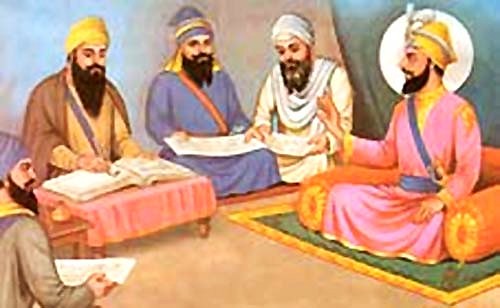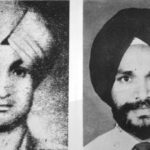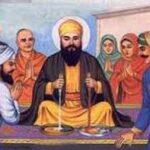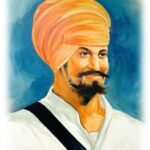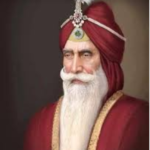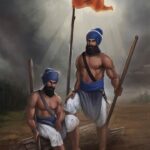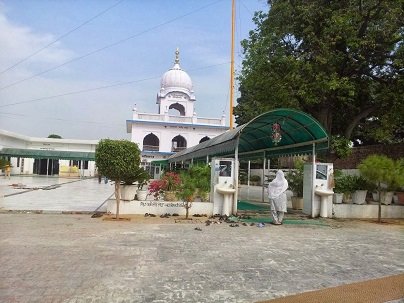Bhai Mani Singh was a Sikh philosopher and martyr who lived in the 18th century. He was a boyhood friend of Guru Gobind Singh and took Sikhism vows when the Guru established the Khalsa in March 1699. Soon after, the Guru dispatched him to Amritsar to assume responsibility for Harmandir Sahib, which had been without a caretaker since 1696. At a key juncture in Sikh history, he assumed command and directed the course of Sikh destiny. How he died, in which he was severed joint by joint, has become a part of daily Sikh Ardas (prayer).
Family Ancestry
Mani Singh was the son of Mai Das of Alipur and was born Mani Ram. Jet (Bhai Jetha Singh) and Dayal Das were his two older brothers.
Mani Singh was one of Mai Das’s 12 sons. Rao Ballu, a respected fighter, and general in Guru Hargobind’s army, was his grandpa. Mani Singh’s lineage included prominent fighters, including his cousin Bhagwant Singh Bangeshwar, who ruled during the reign of Aurangzeb. Dayala, his brother, was assassinated in Delhi alongside Guru Tegh Bahadur. Mani Singh spent a significant portion of his life serving at Harmandir Sahib in Amritsar.
Work and life Guru Har Rai’s Help
When Mani Singh was 13 years old, his father, Rao Mai Das, led him to Kiratpur to pay tribute to Guru Har Rai. Mani Singh worked under Guru Har Rai for almost two years in Kiratpur, scrubbing cooking pans and utensils. He also took care of other errands. Mani Singh’s father petitioned Guru Har Rai for leave to be granted to Mani Singh for a brief period when he was 15 years old. Mani Singh and his father returned to Alipur, where Mani Singh married Bibi Seetobai. Mani Singh then traveled to Kiratpur with his elder brothers, Bhai Jetha Singh and Bhai Dial Das, and presented himself before Guru Har Rai for service at his shrine.
Guru Har Krishan’s Service
Mani Singh began serving Guru Har Krishan after Guru Har Rai died.
Mani Singh was one of the Sikhs who followed Guru Har Krishan on his journey to Delhi.
Guru Tegh Bahadur’s Service
Mani Singh took Guru Har Krishan Ji’s mother, Mata Sulakhani, to Bakala and presented himself before Guru Teg Bahadur for duty when Guru Har Krishan died on March 30, 1664, in Delhi.
Bhai Jetha Singh and Bhai Dial Das, Mani Singh’s elder brothers, also arrived in Bakala to serve alongside the guru. Mani Singh was 20 years old at the time. After some time in the service of Guru Teg Bahahdur, Mani Singh left the Guru and returned to his village in Alipur. Mani Singh later traveled to Anandpur Sahib with his family for the Vaisakhi celebration. Guru Teg Bahadur had recently returned from a preaching tour in the East when he landed at Anandpur Sahib. When Guru Teg Bahadur heard the Kashmiri Pandits’ appeal and desire for assistance in saving the Hindu religion, he decided to travel to Delhi. Bhai Jetha, Mani Singh, and a few other Sikhs remained at Anandpur to look after Guru Gobind Singh. Guru Teg Bahadur was led to Delhi by Bhai Mati Das, Bhai Sati Das, and Bhai Dial Das. They were caught alongside Guru Teg Bahadur and sent to Delhi, where they were all executed.
Guru Gobind Singh’s Service
Guru Gobind Singh’s boyhood buddy was Bhai Mani Singh. He was significantly older than Guru Gobind Singh (who was known as Gobind Rai at the time). Mani Singh stayed with him even after Gobind Rai ji rose to the sacred seat of Guru. Mani Singh accompanied the Guru to the solitude of Paonta, where he spent three years entirely devoted to literary activity.
Mani Singh was not only a profound scholar of Sikh sacred scripture who published works on Sikhi, but he was also a warrior who accompanied Guru Gobind Singh on several occasions as one of his bodyguards. Mani Singh’s valiant actions in numerous fights won him the title of renowned warrior. As the Guru’s Diwan (Minister), he was responsible for many aspects of the Guru’s establishment. Nonetheless, he found time to study Sikh scripture under the Guru’s tutelage and became a skilled theologian. He learned and understood Gurbani so well that he used to give Katha (Exposition) of the Granth Sahib to the Sangat (Congregation) at Anandpur Sahib and thereafter at the Harmandir Sahib.
The establishment of the Khalsa
A mural depicting Udai Singh (also spelled Uday Singh), a slain Sikh and the son of Bhai Mani Singh. Amritsar’s Baba Atal Tower Mural
On Vaisakhi day in 1699, Guru Gobind Singh established the Khalsa Panth, and Bhai Mani Singh received Amrit from Guru Gobind Singh, changing his name from Mani Ram to Mani Singh.
On this day, Bhai Mani Singh’s brothers Rai Singh, Roop Singh, and Man Singh were initiated as Khalsas, as were five of Mani Singh’s sons.
After the Khalsa Panth was established with the famous Amrit ritual and the Rahit Maryada (Khalsa Code of Conduct) was ordained, Guru Gobind Singh dispatched Bhai Mani Singh and five other Khalsas to Amritsar with instructions to take control of the Harmandir Sahib. Bhai Mani Singh was named Granthi of the Harmandir Sahib and Akal Takhat Jathedar. Mani Singh, therefore, became the Harmandir Sahib’s third Granthi, following Baba Buddha and Bhai Gurdas. Apart from the Kirtan Singing of Granth Sahib hymns, Bhai Mani Singh used to give Katha (Exposition of Gurbani), which became a popular daily feature.
